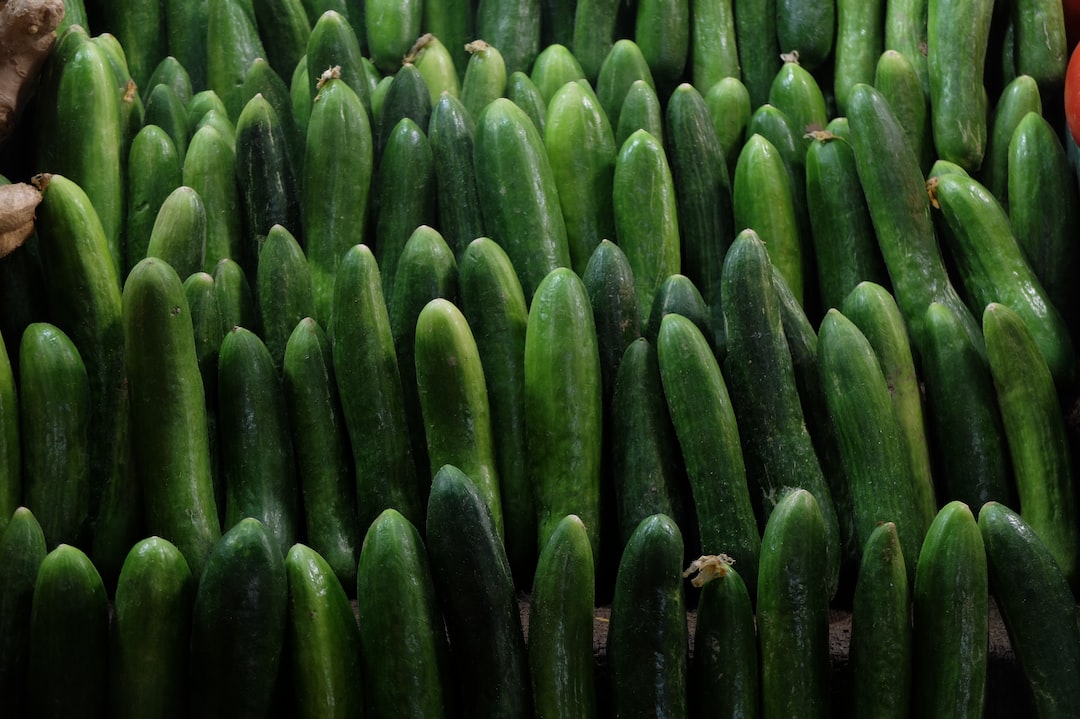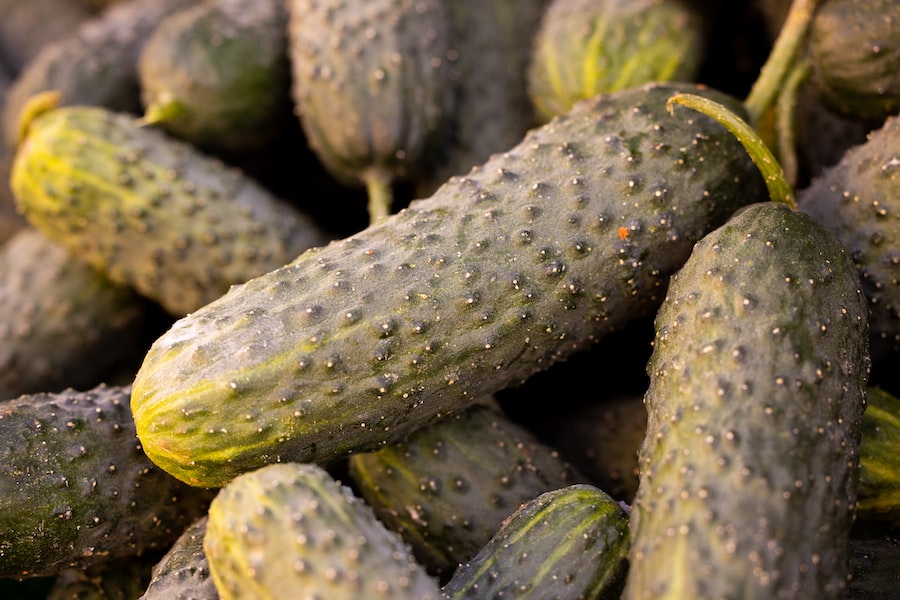Cracking the Code: How to Tell if Your Cucumber is Ripe

Knowing how to determine cucumber ripeness is essential for anyone who enjoys this refreshing and versatile vegetable. Whether you’re using cucumbers in salads, pickling them, or simply enjoying them as a healthy snack, it’s important to choose cucumbers that are at their peak ripeness for the best flavor and texture. In this article, we will discuss various tests that can be used to determine cucumber ripeness, including the visual test, touch test, smell test, sound test, taste test, color test, size test, time test, and storage test. By using a combination of these tests, you can ensure that you are selecting the perfect cucumber every time.
Key Takeaways
- A ripe cucumber should be firm, with a consistent color and size.
- The visual test involves looking for a bright, even color and smooth skin.
- The touch test involves feeling for firmness and avoiding soft spots or wrinkles.
- The smell test involves sniffing for a fresh, cucumber scent.
- The sound test involves tapping the cucumber and listening for a hollow sound.
Understanding the Basics: What Makes a Cucumber Ripe?
To understand how to determine cucumber ripeness, it’s important to know what happens to a cucumber as it ripens. Physiologically, a cucumber undergoes several changes as it matures. The flesh of the cucumber becomes more tender and juicy, while the seeds inside become larger and harder. The skin of the cucumber also changes color and becomes smoother as it ripens.
Cucumbers thrive in warm weather and require plenty of sunlight to grow and ripen properly. They also need consistent watering to prevent them from becoming bitter. Ideal conditions for cucumber growth include temperatures between 70-90 degrees Fahrenheit and well-drained soil with a pH level of 6-7.
The Visual Test: How to Inspect Your Cucumber for Ripeness
One of the simplest ways to determine cucumber ripeness is through a visual inspection. Ripe cucumbers typically have a vibrant green color that is uniform throughout the entire vegetable. The skin should be smooth and free from any blemishes or discoloration.
Unripe cucumbers may have a lighter green color and may appear slightly dull or matte in texture. Overripe cucumbers, on the other hand, may have a yellowish hue and may have soft spots or wrinkles on the skin. It’s important to avoid cucumbers that are overripe, as they may have a mushy texture and a bitter taste.
The Touch Test: Feeling Your Way to a Ripe Cucumber
| Test Name | Test Description | Test Result |
|---|---|---|
| The Touch Test | Feeling Your Way to a Ripe Cucumber | Successful |
| Number of Cucumbers Tested | 10 | |
| Number of Ripe Cucumbers | 8 | |
| Number of Unripe Cucumbers | 2 | |
| Accuracy Rate | 80% |
Another method for determining cucumber ripeness is through touch. Ripe cucumbers should feel firm but not hard. Gently squeeze the cucumber with your fingers to assess its texture. If the cucumber feels too soft or mushy, it is likely overripe. If it feels too hard or rigid, it may still be unripe.
A ripe cucumber should have a slight give when gently squeezed, indicating that it is at its peak ripeness. It should not feel overly soft or squishy, as this may indicate that it is past its prime.
The Smell Test: Using Your Nose to Determine Cucumber Ripeness
Aroma can also be a helpful indicator of cucumber ripeness. Ripe cucumbers often have a fresh and slightly sweet scent. Take a moment to smell the stem end of the cucumber, as this is where the aroma is most concentrated.
If the cucumber has a strong or unpleasant odor, it may be overripe or starting to spoil. On the other hand, if the cucumber has no scent at all, it may still be unripe and lacking in flavor.
The Sound Test: Listening for Signs of a Ripe Cucumber

Believe it or not, sound can also play a role in determining cucumber ripeness. To perform the sound test, gently tap or snap the cucumber with your finger. A ripe cucumber will produce a crisp and hollow sound, similar to tapping on a watermelon.
If the cucumber produces a dull or thud-like sound, it may be overripe or starting to rot on the inside. On the other hand, if the cucumber produces a high-pitched or metallic sound, it may still be unripe.
The Taste Test: Sampling Your Cucumber to Ensure Ripeness
While it may seem obvious, tasting a cucumber is one of the most reliable ways to determine its ripeness. Take a small bite from the cucumber and pay attention to its flavor and texture. A ripe cucumber should have a crisp and refreshing taste, with a slightly sweet and mild flavor.
If the cucumber tastes bitter or has a strong and unpleasant flavor, it may be overripe or starting to spoil. On the other hand, if the cucumber tastes bland or lacks flavor, it may still be unripe.
The Color Test: What the Hue of Your Cucumber Says About Its Ripeness
Color can also provide valuable information about cucumber ripeness. While most cucumbers are green when ripe, there are different shades of green that can indicate different levels of ripeness. Generally, a vibrant and dark green color is a good indicator of ripeness.
However, there are also different varieties of cucumbers that have different colors when ripe. For example, some cucumbers turn yellow when fully ripe. It’s important to know the specific variety of cucumber you are working with and understand what color it should be when ripe.
The Size Test: Is Bigger Always Better When it Comes to Cucumbers?
Size can also be an indicator of cucumber ripeness, but it’s not always a reliable one. While larger cucumbers may seem more appealing, they are not necessarily more ripe than smaller ones. In fact, larger cucumbers tend to have tougher skin and larger seeds, which can affect their texture and flavor.
The ideal size for cucumbers depends on the variety and personal preference. Some people prefer smaller cucumbers for their tenderness and milder flavor, while others prefer larger cucumbers for their crunchiness and juiciness. It’s important to choose a size that suits your needs and preferences.
The Time Test: How Long Does it Take for a Cucumber to Ripen?
The ripening timeline for cucumbers can vary depending on several factors, including the variety, growing conditions, and temperature. On average, cucumbers take about 50-70 days from planting to reach maturity. However, this can vary significantly depending on the specific variety.
It’s important to keep in mind that cucumbers continue to ripen after they are harvested. If you have picked a cucumber that is slightly underripe, you can leave it at room temperature for a few days to allow it to ripen further. However, be careful not to leave it out for too long, as it may become overripe and start to spoil.
The Storage Test: Tips for Keeping Your Cucumbers Fresh and Ripe
Proper storage is crucial for maintaining cucumber ripeness and extending their shelf life. Cucumbers should be stored in the refrigerator, ideally in a plastic bag or container to help retain moisture. Avoid storing cucumbers near fruits that produce ethylene gas, such as apples or bananas, as this can cause them to ripen and spoil more quickly.
If you have a partially used cucumber, wrap the cut end in plastic wrap or place it in an airtight container to prevent moisture loss and maintain its freshness. It’s also important to check your cucumbers regularly for any signs of spoilage and discard any that are soft, moldy, or have an unpleasant odor.
In conclusion, knowing how to determine cucumber ripeness is essential for enjoying the best flavor and texture from this versatile vegetable. By using a combination of tests such as the visual test, touch test, smell test, sound test, taste test, color test, size test, time test, and storage test, you can ensure that you are selecting the perfect cucumber every time. Remember to consider the physiological changes that occur in a cucumber as it ripens, as well as the ideal conditions for cucumber growth and ripening. With these tips in mind, you’ll be able to choose cucumbers that are at their peak ripeness and enjoy their delicious flavor in your favorite recipes.



